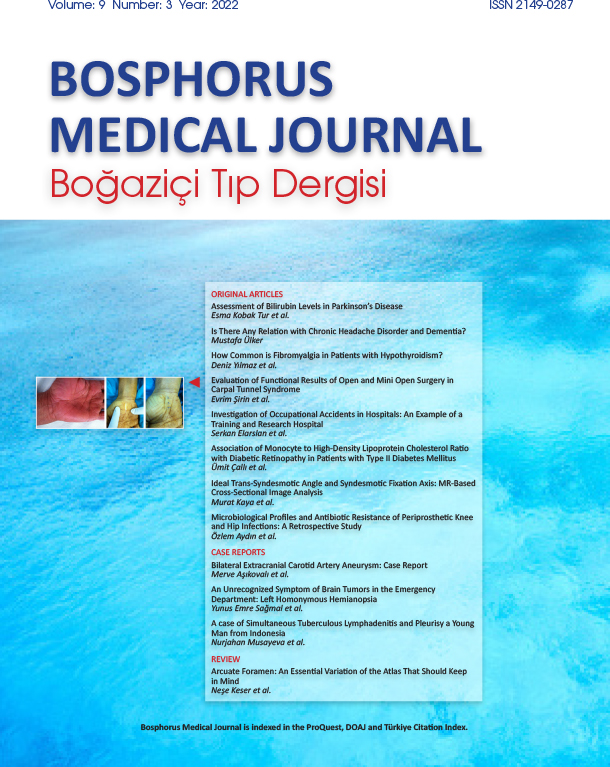Ocular Vestibular Evoked Myogenic Potentials in Patients with Multiple Sclerosis
Eren Gözke, Zeliha Baştürk Ayhan, Nursel Erdal, Nurbanu Gürbüzer, Meryem Kaydan, Pelin Doğan AkFSM Teaching and Research Hospital, Department of Neurology, Istanbul, TurkeyINTRODUCTION: Vestibular evoked myogenic potential (VEMP) test is a technique based on activation of vestibular apparatus by acoustic stimulation. In
this study we aimed to investigate the presence of vestibulopathy in patients with relapsing remitting multiple sclerosis (RRMS) who have not vestibular complaints using ocular VEMP (oVEMP) test.
METHODS: Forty patients diagnosed as RRMS according to revised McDonald criteria and 30 healthy controls were enrolled in the study. oVEMP tests were performed through contralateral inferior oblique muscles. Active electrode was placed on the lower eyelid, and the reference electrode was attached 1cm below. The patients were requested to stare towards a superolateral direction so as to activate inferior oblique muscle. Meanwhile 120 dB click stimulation was delivered to the contralateral ear at 10/sec for 150 sec, and 1500 responses were averaged. The test was repeated twice for each side and the latencies and amplitudes of the initial negative (N1) and positive (P1) waves were measured. Availability of any response, their latencies and amplitudes were compared.
RESULTS: Nine cases of RRMS (22.5 %) could not yield any response in both sides, while in the control group no bilateral response was obtained in 4 cases (13.3%). Also in RRMS group no unilateral response was obtained in 5 (12.5%) cases. In the RRMS group mean latencies of N1 and P1 were significantly longer, while N1-P1 amplitudes were found to be meaningfully lower.
DISCUSSION AND CONCLUSION: These findings demonstrate that using oVEMP test subclinical vestibulopathy can be elicited in RRMS patients without vestibular complaints.
Multipl Skleroz Olgularında Oküler Vestibüler Uyarılmış Potansiyeller
Eren Gözke, Zeliha Baştürk Ayhan, Nursel Erdal, Nurbanu Gürbüzer, Meryem Kaydan, Pelin Doğan AkFSM Teaching and Research Hospital, Department of Neurology, Istanbul, TurkeyGİRİŞ ve AMAÇ: Relapsing-remitting Multipl Skleroz (RRMS) olgularında oküler vestibüler uyarılmış myojenik potensiyel (oVEMP) incelemesi ile subklinik vestibülopati varlığının araştırılması amaçlandı.
YÖNTEM ve GEREÇLER: Revize McDonald tanı kriterlerine göre RRMS tanısı konan, atak dışı dönemde ve vestibüler yakınması olmayan 40 (23 kadın, 17
erkek) olgu ile 30 (21 kadın, 9 erkek) sağlıklı birey incelendi. Alt göz kapağı üzerine konan yüzeyel elektodlarla yapılan kayıt sırasında kontrlateral kulağa 120 dB klik uyarı verildi ve bu sırada inferior oblik kası aktive etmek için hastanın üst laterale bakması istenerek elde edilen 1500 yanıt averajlandı. İlk negatif dalga N1, ilk pozitif dalga P1 olarak adlandırıldı. Çalışma iki taraf için iki kez tekrarladı ve ortalamaları alındı.
BULGULAR: RRMS olgularından 9unda (%22.5) kontrol grubunun 4ünde (%13.3) bilateral cevap elde edilemedi. Ayrıca RRMS grubunda 5 (%12.5)
olguda tek taraflı cevap elde edilmedi. RRMS grubunda N1 ve P1 ortalama latansları anlamlı uzun, N1-P1 amplitüdleri anlamlı düşük bulundu.
TARTIŞMA ve SONUÇ: Bu bulgular oVEMP incelemesinin RRMS olgularında subklinik vestibülopatiyi değerlendirmede yararlı olduğunu ortaya koymaktadır
Manuscript Language: English




















